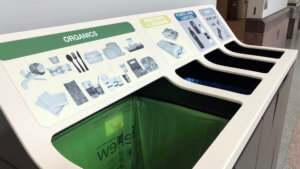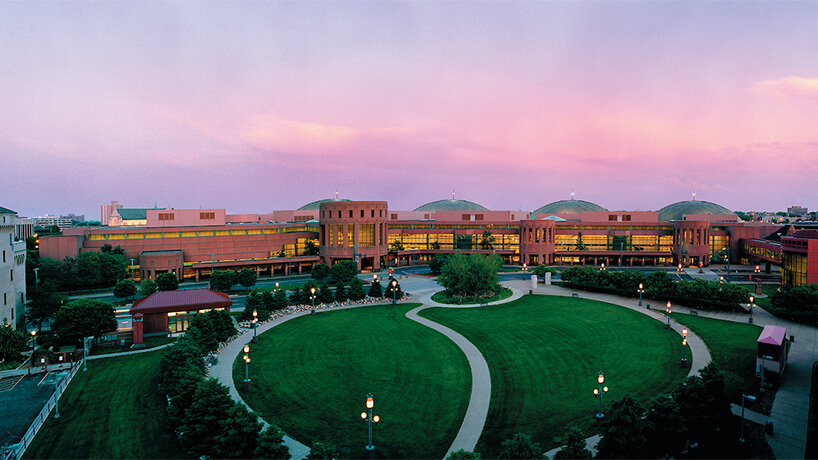Several years ago, when the Minneapolis Convention Center’s leaders talked to staff about what mattered to them, sustainability turned out to be top of mind. Here’s a case-study look at how that has played out.
When attendees walk into the Minneapolis Convention Center, window decals that celebrate its 2017 recognition as a LEED-certified building greet them at the entrance. However, earning that four-letter acronym — the U.S. Green Building Council’s recognition for Leadership in Energy and Environmental Design — involved more than a mandate from the building’s leadership. It started with those leaders wanting to give all of the convention center’s employees a reason to feel like they were making an impact on the entire world, not just on the events hosted in the convention center.
“We talked to our staff about what was important to them and what excited them,” Jeff Johnson, executive director of the Minneapolis Convention Center, told PCMA. “Sustainability emerged as something that could really rally our entire staff together. It was important to identify something that they cared about. If we had just said ‘this is what we’re doing,’ it wouldn’t have mattered.”
That initial conversation was in 2011. In 2012, when the center officials first measured performance, they were recycling only around 41 percent of the materials used in the building. They set an ambitious goal to increase the recycling rate to 60 percent. They reworked back-of-the-house systems and redesigned front-of-the-house trashcans into what Johnson calls “the most beautiful and easy-to-use waste collection sites you’ll see.” Unlike traditional recycling bins that use logos, the center’s bins feature images of utensils, cups, bottles, and the other specific materials in order to take the guesswork out of what goes where. That kind of attention to detail has helped the building maintain a recycling rate of 60 percent for the past three years.
In addition to increasing recycling rates, the convention center has prioritized reducing water usage. “Being located on the Mississippi, what we do here impacts what happens downstream,” Johnson said. “So the reduction in water was something that our staff could grab on to as well.”
From redesigning half of the restrooms to make them at least 50-percent more water-efficient (the other half are currently in progress) to installing a 250,000-gallon tank that catches five million gallons of rainwater each year for irrigation needs, many of the facility’s capital- improvements costs have gone to those water-reduction efforts. New dishwashers and new water nozzles contribute to water-conservation efforts and move the convention center closer to its goal of cutting overall water usage in half by 2020.

A recycle bin in Minneapolis Convention Center
A Culture of Caring for the Environment
These are all impressive numbers, but Mark Zirbel, director of facility and event services at the convention center, told PCMA that watching how the staff has gotten behind sustainability efforts has been even more powerful. “The staff growth is probably the most significant accomplishment,” Zirbel said. “We have all this data, but seeing the workforce embrace this movement has been really amazing.”
A monthly report has been helping to keep the building’s approximately 200 full-time employees engaged in the movement. Each receives an analysis each month with statistics about recycling, water usage, and electricity usage. For example, they know that in Q3 of 2018, they helped recycle more than 120 tons of waste and achieved a 64-percent recycle rate. “It’s a regular reminder of what they’re doing each day to help the building be better,” Zirbel said.
Johnson and Zirbel are focused on making that reminder resonate with the employees who work for their partners, too, such as catering and security employees who are hired based on rotating needs. “Having everyone buy into the mission,” Johnson said, “is part of our ongoing effort.”
Extending the Mission to Clients
“Everyone” also includes the event organizers who bring their groups to the convention center. At the beginning of 2018, Zirbel began sending all organizers who hosted events at the convention center a Client Sustainability Report. The one-page PDF offers an overview of an event’s waste, water, and energy. “It looks at square footage and how they used the building,” Zirbel said. “It’s a way to take each piece of the puzzle and show how an organizer is being responsible by choosing us as a destination.”
Because the center uses electricity sourced from renewable sources, “the carbon offset is phenomenal,” Zirbel said, although, he added, many people don’t understand the true definition of a carbon footprint. With that in mind, the report breaks things down into an easy-to-grasp manner. For example, the report from the inaugural MANOVA health-care summit in October offered these details “Your event consumed 49 thousand gallons of water, or 1,386 bathtubs, and 0.6 million kBtus of energy, or the annual use of two U.S homes,” it reads. “Water and energy conservation efforts reduced your event’s carbon impact by 15% or the amount of carbon offset by 5,910 trees in one year.”
The convention center earned the 2018 Venue Excellence Award from the International Association of Venue Managers (IAVM), an honor Johnson and Zirbel are quick to attribute to their staff. “We asked them to do something harder than what they were doing before,” Johnson said. “It’s more work to separate waste and more work to be conscious about using water and energy. But they’ve owned it. Taking care of the planet is part of the culture now.”

